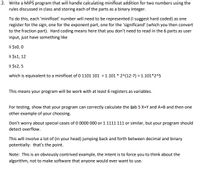
Database System Concepts
7th Edition
ISBN: 9780078022159
Author: Abraham Silberschatz Professor, Henry F. Korth, S. Sudarshan
Publisher: McGraw-Hill Education
expand_more
expand_more
format_list_bulleted
Question
Please help me write a MIPS program that actually works

Transcribed Image Text:2. Write a MIPS program that will handle calculating minifloat addition for two numbers using the
rules discussed in class and storing each of the parts as a binary integer.
To do this, each 'minifloať number will need to be represented (I suggest hard coded) as one
register for the sign, one for the exponent part, one for the 'significand' (which you then convert
to the fraction part). Hard coding means here that you don't need to read in the 6 parts as user
input, just have something like
li $s0, 0
li $1, 12
li $2, 5
which is equivalent to a minifloat of 0 1101 101 = 1.101 * 2^(12-7) = 1.101*2^5
This means your program will be work with at least 6 registers as variables.
For testing, show that your program can correctly calculate the Lab 5 X+Y and A+B and then one
other example of your choosing.
Don't worry about special cases of 0 0000 000 or 1 1111 111 or similar, but your program should
detect overflow.
This will involve a lot of (in your head) jumping back and forth between decimal and binary
potentially: that's the point.
Note: This is an obviously contrived example, the intent is to force you to think about the
algorithm, not to make software that anyone would ever want to use.
Expert Solution
This question has been solved!
Explore an expertly crafted, step-by-step solution for a thorough understanding of key concepts.
Step by stepSolved in 2 steps

Knowledge Booster
Learn more about
Need a deep-dive on the concept behind this application? Look no further. Learn more about this topic, computer-science and related others by exploring similar questions and additional content below.Similar questions
- Please help with the following Computer Science question:arrow_forwardSiemens programming uses the letter 'Q' to indicate an output address. What letter does the Allen Bradley software use? (Just the letter for an answer)arrow_forwardWrite assembly code that compare two different integer numbers in a loop. Increment the lowest number till they are equal. If the numbers are equal exit. Implement conditional and unconditional jump instructionsarrow_forward
- It is well known that computers operate in binary. Why aren't alternative systems like decimal, octal, and sixteenth used instead?arrow_forwardCan someone please show me a program written in mips that will calculate the nth root of any number written from the beginning. I have a formula but I can't get it into code. Thank you!arrow_forwardCreate a MASM assembly program called "Equation.asm" that calculates the following: A = B * 3 +6 / (X + D) where B == 10, X == 4, D == 2 Define all variables as Word. Make sure you use: .model small.586.stack 100h.data.codearrow_forward
arrow_back_ios
arrow_forward_ios
Recommended textbooks for you
 Database System ConceptsComputer ScienceISBN:9780078022159Author:Abraham Silberschatz Professor, Henry F. Korth, S. SudarshanPublisher:McGraw-Hill Education
Database System ConceptsComputer ScienceISBN:9780078022159Author:Abraham Silberschatz Professor, Henry F. Korth, S. SudarshanPublisher:McGraw-Hill Education Starting Out with Python (4th Edition)Computer ScienceISBN:9780134444321Author:Tony GaddisPublisher:PEARSON
Starting Out with Python (4th Edition)Computer ScienceISBN:9780134444321Author:Tony GaddisPublisher:PEARSON Digital Fundamentals (11th Edition)Computer ScienceISBN:9780132737968Author:Thomas L. FloydPublisher:PEARSON
Digital Fundamentals (11th Edition)Computer ScienceISBN:9780132737968Author:Thomas L. FloydPublisher:PEARSON C How to Program (8th Edition)Computer ScienceISBN:9780133976892Author:Paul J. Deitel, Harvey DeitelPublisher:PEARSON
C How to Program (8th Edition)Computer ScienceISBN:9780133976892Author:Paul J. Deitel, Harvey DeitelPublisher:PEARSON Database Systems: Design, Implementation, & Manag...Computer ScienceISBN:9781337627900Author:Carlos Coronel, Steven MorrisPublisher:Cengage Learning
Database Systems: Design, Implementation, & Manag...Computer ScienceISBN:9781337627900Author:Carlos Coronel, Steven MorrisPublisher:Cengage Learning Programmable Logic ControllersComputer ScienceISBN:9780073373843Author:Frank D. PetruzellaPublisher:McGraw-Hill Education
Programmable Logic ControllersComputer ScienceISBN:9780073373843Author:Frank D. PetruzellaPublisher:McGraw-Hill Education

Database System Concepts
Computer Science
ISBN:9780078022159
Author:Abraham Silberschatz Professor, Henry F. Korth, S. Sudarshan
Publisher:McGraw-Hill Education

Starting Out with Python (4th Edition)
Computer Science
ISBN:9780134444321
Author:Tony Gaddis
Publisher:PEARSON

Digital Fundamentals (11th Edition)
Computer Science
ISBN:9780132737968
Author:Thomas L. Floyd
Publisher:PEARSON

C How to Program (8th Edition)
Computer Science
ISBN:9780133976892
Author:Paul J. Deitel, Harvey Deitel
Publisher:PEARSON

Database Systems: Design, Implementation, & Manag...
Computer Science
ISBN:9781337627900
Author:Carlos Coronel, Steven Morris
Publisher:Cengage Learning

Programmable Logic Controllers
Computer Science
ISBN:9780073373843
Author:Frank D. Petruzella
Publisher:McGraw-Hill Education